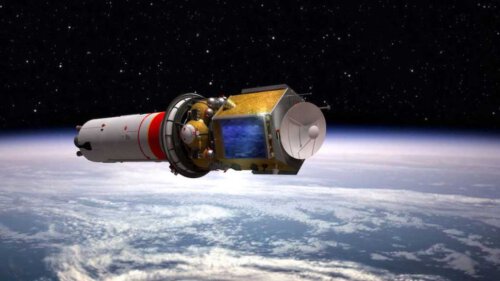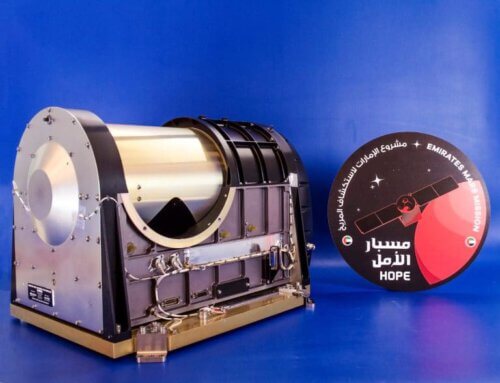
The United Arab Emirates' Mars Hop mission reached orbit around it this evening at approximately 17:30 p.m. Israel time after the maneuver performed by the ground crew members was successful.
On July 19, 2020, the Emirates mission Mars Al-Amal ("Hope" in Arabic) - was launched from the Tangashima Space Center in Japan on its way to Mars. This mission, the first interplanetary effort of its kind built by an Arab country, is managed from the control center at the Mohammed Bin Rashid Space Center (MBRSC) in the United Arab Emirates in collaboration with several research institutions around the world.
Hope will spend the next two years collecting vital scientific data on the Martian atmosphere.

One of the spacecraft's primary instruments, the ASU-built Emirates Infrared Spectrometer (EMIRS), will examine temperature, ice, water vapor and dust profiles in the Martian atmosphere. Credit: MBRSC/Aso/Nau/CU-LASP
The Mars orbit insertion phase involved burning about half the amount of fuel in the spacecraft's maneuvering engines to slow it down to the point where it would be captured by Mars. The burn lasted about 27 minutes and reduced the probe from its cruising speed of more than 121,000 km/h to about 17,700 km/h. A pre-burn device test will be performed to ensure the probe is ready for this crucial step.
Kamran Sharaf, head of the United Arab Emirates' Mars Mission and Northern Arizona University (NAU) staff wrote in a statement that they published: "The Mars spacecraft Hope is reaching its destination at the end of a six-year development journey by the team at the Mohammed bin Rashid Space Center working together with our knowledge partners. This is an accelerated time frame by the standards of an interplanetary mission. The mission has truly transformed the Emirates' capability in space systems engineering, science and research and has had a hugely positive impact on our science community at large."
The spacecraft carries three interferometers, such as the Emirates Infrared Infrared Spectrometer for Mars (EMIRS) developed in partnership with Arizona State University's (ASU) School of Earth and Space Studies and NAU's Department of Astronomy and Planetary Science. This instrument will be responsible for investigating the distribution of dust, ice clouds and ozone in the lower and middle atmosphere of Mars.
The instrument will also track the movement of water vapor and heat through the atmosphere, providing scientists with a unique view of the Martian atmosphere and the dynamics that drive it. Said Philip Christensen, ASU board member professor and planetary scientist:
“Working with the UAE scientists and engineers on their first planetary space mission was a new and amazing experience for us. They brought a lot of excitement and enthusiasm to the project and were a real pleasure to work with. The EMIRS instrument will provide a completely new look at the Martian atmosphere, and we all look forward to the new discoveries and better understanding of the Martian climate that it will give us."
In addition, the spacecraft contains a camera (EXI) and an ultraviolet spectrometer (EMUS), both of which were developed at the Laboratory for Atmospheric and Space Physics (LASP) at the University of Colorado at Boulder. The EXI camera will assist the Emirates by taking high-resolution images of the Martian atmosphere and measuring the concentration of water, ice, dust, aerosols and ozone in the Martian atmosphere. The EMUS spectrometer will measure global properties and variations in the thermosphere as well as the hydrogen and oxygen corona.
Christopher Edwards, NAU assistant professor and planetary scientist said: After traveling millions of miles from Earth to Mars for the past seven months, the Emirates Mars Mission is about to embark on the next chapter of its mission and ultimate goal. I am happy to say that after validating the instrument's performance during the journey to Mars, EMIRS is ready to perform the measurements that the team has been working towards for the past five years."
The ultimate goal of the Hop mission is to provide an unprecedented global view of the Martian atmosphere and learn more about its dynamic nature. As previous missions have shown, Mars has a turbulent history and is still a very active world, with many forces constantly changing its landscape. Through global warming, scientists are going to learn more about the connections within and between the upper and lower atmosphere.
The research should eventually shed more light on the process of the escape of the atmosphere, which was a major factor in the climatic and geological evolution of Mars. Billions of years ago, Mars had a denser atmosphere and was able to maintain temperatures warm enough to maintain liquid water on its surface. However, the slow loss of its atmosphere to space caused it to transform from a warmer, softer planet into the arid, coldest world it is today.
Thanks to the unique orbit of the HOPE mission, the spacecraft will be able to provide an almost complete level of daily and geographic coverage, effectively monitoring the Martian atmosphere in the same way that weather satellites operate in orbit around Earth. This will allow for a significant improvement in weather forecasting, something that will be of vital importance when the time comes to send human missions to Mars.
The data collected by Hope will also give scientists greater insight into how the planet has evolved over time, key to understanding how terrestrial (rocky) planets can maintain stable climates and support life. This insight will make it possible to build more detailed climate models that will be used to characterize planets outside the solar system in the future (hopefully finding habitable worlds beyond the solar system).
Sheikh Mohammed bin Rashid Al Maktoum (Ruler of the Emirate of Dubai and after whom the MBRSC is named), the name of the mission was chosen to convey a message of hope and optimism to millions of young Arabs who are looking to make valuable contributions to space exploration and all fields of science, technology and engineering, astronomy and mathematics.
More of the topic in Hayadan:
